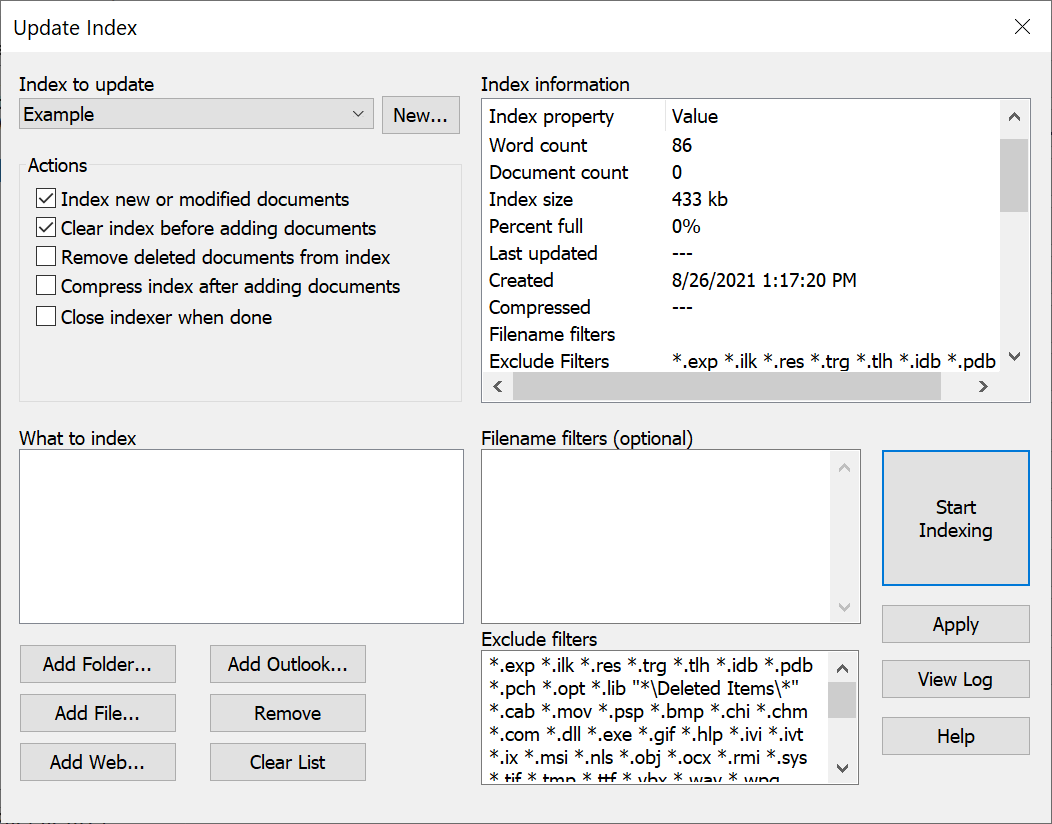Indexing Documents
To add documents to a new index:
1. Click Index > Create Index to create the new index. Enter the name of the index to create and click OK.
2. dtSearch will ask if you want to add documents to the index. Click Yes.

3. In the Update Index dialog box, click Add Folder... or Add File... to add folders or files to be indexed. You can also drag and drop files or folders from Explorer into the "What to index" box. A "<+>" after a folder name means that subfolders will also be indexed. Right-click a folder name and select "Include subfolders" or "Do not include subfolders" to add or remove the <+> mark.
4. (Optional) Under Filename filters, enter filters (*.DOC, *.TXT, etc.) to select documents to add. If you leave this blank, dtSearch will index all of the files in the directories you selected. Under Exclude filters, enter filters (such as *.EXE) for any files you do not want to include in the index.
5. Click Start Indexing.
To update an existing index:
1. Click Index > Update Index.
2. Select the index to update from the list.
3. Make any changes to the list of folders to be indexed. Click Remove to remove the selected folder or Add Folder... to add a folder.
4. Check Index new or modified documents if it is not already checked.
5. If you have deleted or moved some files that were in the index and you want to remove them from the index, check Remove deleted documents from index.
6. If you have updated the index several times, you may want to check Compress index after adding documents. Compressing an index optimizes the index structure, removing obsolete data and defragmenting search structures for better performance. Obsolete data comes from documents that are reindexed and from documents that are removed from the index. In both cases, the data is not removed from the index but is tagged as "obsolete" for removal the next time the index is compressed. It can take a while (dtSearch completely reconstructs the index) but it makes the index smaller and makes searches faster.
7. Click Start Indexing.
To schedule updates to occur automatically, see "Scheduling Index Updates."
To rebuild an index:
To tell dtSearch to rebuild an index, check the Clear index before adding documents box, check the Index new or modified documents box, and click Start Indexing.
To update multiple indexes:
To update more than one index at a time, click Index > Index manager... and then click the Update Multiple Indexes... button. Check the box next to each index to be updated, and check the boxes indicating the tasks to be performed, and click Start Indexing.
Notes
Supported File Types
For a list of the file formats that dtSearch supports, see "What file formats does dtSearch support".
Indexing Large Document Collections
For suggestions to improve indexing of large document collections, see "Optimizing indexing of large document collections" at https://support.dtsearch.com.
UNC Paths
To index documents using UNC paths rather than mapped letter drives, select folders under Network Neighborhood in the Add Folder dialog box. You can also convert a network folder in the What to index list to UNC format. To convert a network folder name to UNC format, right-click the folder name you want to convert and choose Make UNC from the menu that pops up.
Subfolders
A "<+>" after the folder name indicates that subfolders will also be indexed. To remove the <+> mark after a folder name, right-click on the folder name and choose Do not index subfolders from the menu that pops up.
Disk Space
An index is usually about one-third to one-fourth the size of the original documents, though this can vary depending on the number and type of documents.
Indexing Documents on Removable Drives
When an index contains documents stored on floppy disk or other removable media such as a CD-ROM, make sure that Remove deleted documents from index is not checked when you update the index. You may find it useful to store the documents on each disk in a subdirectory named after the disk. For example, if you have disks labeled SMITH and JONES, move the documents on the SMITH disk into a directory called SMITH, and move the documents on the JONES disk into a directory called JONES. This will help you to locate the documents after a search. You can see which disk has the documents you want by looking at the directory name in search results.
Relative Paths
When documents are on the same drive as the index, dtSearch will automatically use relative paths to store document locations. If you add c:\Sample\Documents\smith.doc to an index in c:\Sample\Index, the index will store the document path as ..\Documents\smith.doc.